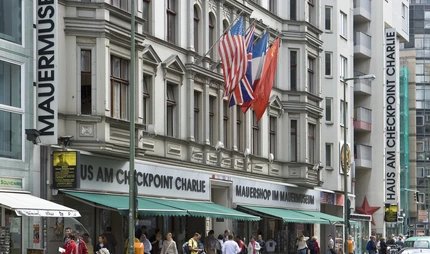
Stasi Museum
Research Centre and Memorial at Normannenstrasse
GDR history where it happened
In Normannenstraße, to the east of Berlin city centre, you'll find the Stasi Museum, formerly home of the Ministry of State Security. In this building you can discover how the Stasi operates and take a look at their original technology such as bugs, hidden cameras and weapons. The main attraction is the office of Erich Mielke, Minister of State Security and head of the Stasi from 1957 to the fall of the Berlin Wall in 1989. The second floor of the building remains untouched since the days of the Stasi, complete with desks, chairs and filing cabinets.
Understand German history inside the Stasi Museum
The complex of buildings at Normannenstraße is the original financial office for the surrounding district, and it is not until 1961 that the Ministry of National Security is established in the building. Building Number 1 is then occupied by Erich Mielke for almost three decades. During the 1970s, the size of the Stasi operation expands greatly and occupies the whole site, even taking over an Apostolic Church building. This building complex becomes the control centre for surveillance throughout East Germany and an embodiment of state power. The ministry remains until the fall of the Berlin Wall in 1989, and on 15th January 1990 the building is occupied by demonstrators. There is a growing popular demand to disband the Stasi's operations and make their files public, and the process moves quickly.
By November 1990 a volunteer group mount the first public exhibition in the building, allowing ordinary East Germans in for the first time in decades - something unthinkable only a few months before. Today's visitors can see the permanent exhibition on State Surveillance during the GDR era and see the highly secretive methods used for spying on citizens. One of the stand-out exhibits is Mielke's red briefcase, in which he keeps the most sensitive information, including files on his own boss Erich Honecker. The museum also explains how informants are recruited, how the population is controlled, and ordinary people share how surveillance impacts their lives. At the heart of the museum on the second floor are the Ministerial offices, where even the curtains and telephones are untouched from the days when they were occupied by Mielke and his colleagues. The only things removed from the museum are the Stasi files, so numerous that the indexing and cataloguing process is still ongoing.
Stasi Museum Highlights
- Erich Mielke's ministerial office
- Permanent exhibits on state surveillance in East Germany
- Personal testimonies from people under surveillance
- Spy equipment and technology such as microphones and hidden cameras
- Casino and conference room on the ministerial floor
Finding out more about East Germany and Berlin
Normannenstraße is also home to exhibitions on revolution and the fall of the Berlin Wall, and include period TV recordings, news reels, documents and other media from the point of view of those who experienced it. Another interesting building is the archives of the Federal Commissioner for the Stasi documents, around 20 minutes on the underground from the Stasi Museum. Guided tours around the archives are available in English for groups booked in advance. You can also visit the site of the former men's prison at Rummelsburg, which tells stories from 21 different prisoners through Berlin's history, including the GDR. Another interesting site is the former political prison at Hohenschönhausen, where the cells and interview rooms are preserved to give insight into the methods used by the regime. Tours are guided by former prisoners who tell you about their experiences. It will take about 30 minutes by tram or bus to get to the museum. Something a little different, but still relevant to life in the East German regime is the Computerspielemuseum (Museum of Computer Games), only 15 minutes on the U5 underground line from the Stasi Museum. This unusual museum has 300 exhibits covering the history of gaming from the earliest personal computers to the latest games consoles. Their prized exhibit is the only slot gambling machine allowed in the GDR, known as Poly-Play.
Visiting the Stasi Museum
The easiest way of getting to the Stasi Museum is on the U-Bahn (underground). Take the U5 line to Magdalenenstraße, and the museum is another 10 minutes' walk from there. Alternatively, take the overground S-Bahn to Frankfurter Allee. For drivers, the parking spaces belonging to the museum are easily accessible. If you are visiting as a group, pre-book a guided tour by email. If you have a Berlin WelcomeCard, you will get 25% off the entry fee and 33% off a student ticket. Please note that the museum only accepts cash. The museum is open every day, including weekends and public holidays.
Mon - Fri: 10.00 - 18.00 hrs
Sat, Sun: 11.00 - 18.00











